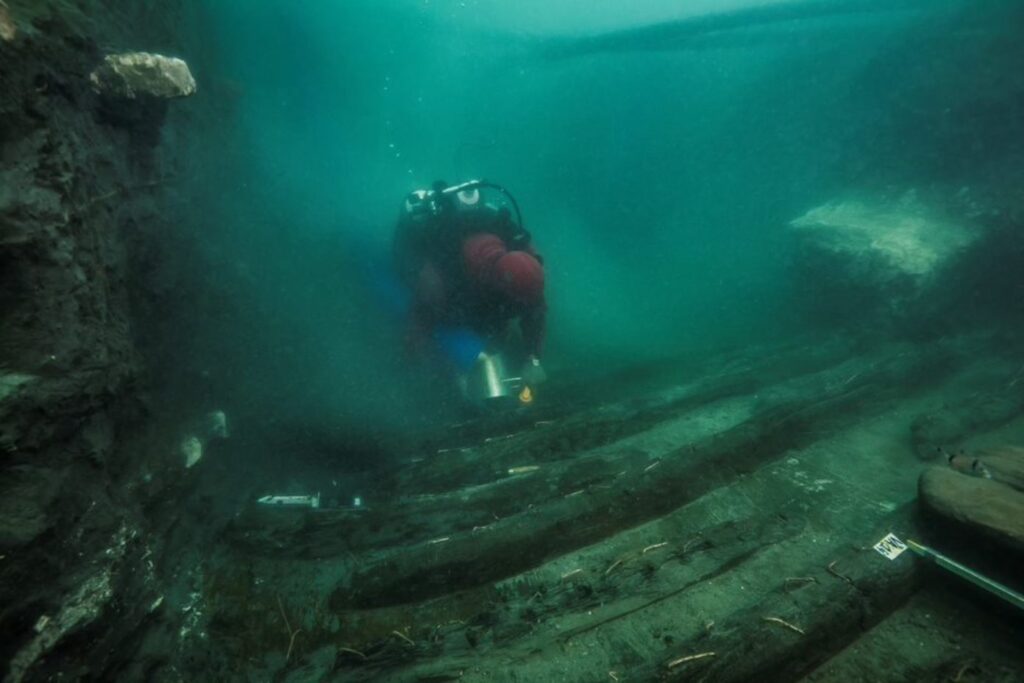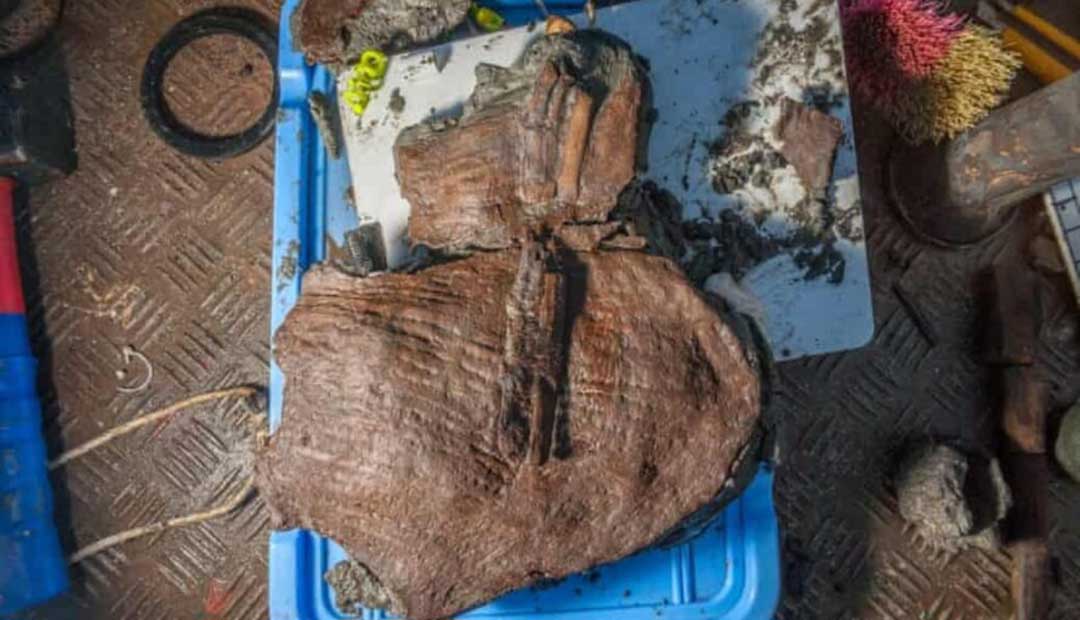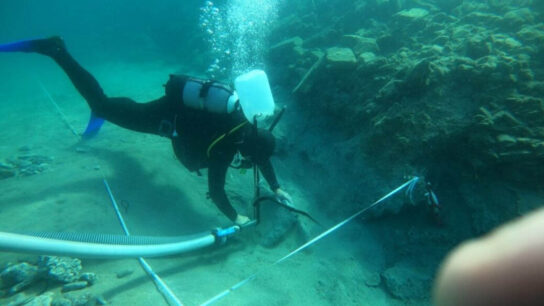2,200-Year-Old Fruit Baskets Found in the Underwater City of Heracleion
Fruit baskets — with fruit still inside — that are more than 2,200 years old were discovered recently in the ruins of Thonis-Heracleion, the ancient lost city near Alexandria, Egypt.
The city, once the nexus of Mediterranean trade routes in the Hellenistic era, sank beneath the waves in the second century BC as the result of earthquakes and tidal waves that liquified the ground underneath it.
Imposing temples, such as the one dedicated to Amon, or Herakles, fell into the water and lay untouched there until the year 2000 when French diver Franck Goddio discovered them and brought many of them to the surface.
When the stones fell they trapped boats and cargo under them, preserving them in the clay of the sea bottom. This ensured that spectacular discoveries, such as Goddio’s recent find of a Greek/Egyptian wooden ship, would be protected from the ravages of time.

But no one expected to discover an intact basket — complete with the fruit it held — almost 2200 years later.
The wooden vessel, along with hundreds of ancient ceramic vases and amphorae — some of them meant for use in burials — as well as bronze treasures have been recently discovered in the waters containing the remains of the legendary city of Thonis-Heracleion off the coast of Alexandria, Egypt.
The ship had been moored at a wharf in the canal that flowed along the south face of the temple when the disaster occurred. The fallen blocks protected this ancient Greek shipwreck by pinning it to the bottom of the deep canal, which was then filled with clay and the debris of the sanctuary. The shipwreck lies under 5 meters (15 feet) of hard clay, mingled with the remains of the temple.
Fruit basket from Heracleion only the latest spectacular finds at the site of the lost city.
Almost miraculously, the ancient Greek ship was only detected through the use of a cutting-edge sonar prototype called a “sub-bottom profiler.”
“The finds of fast galleys from this period remain extremely rare”, explains Goddio, “the only other example to date being the Punic Marsala Ship from 235 BC.
The remains of the city sank even further into the clay bottom of the sea in the eighth century AD, following further natural disasters, including additional earthquakes and tidal waves. The city served as Egypt’s largest port on the Mediterranean Sea even before Alexander the Great founded Alexandria in the year 331 BC, with the intention of that city becoming his capital.

One of the greatest archaeological finds of recent times was made in the years 1999 and 2000 when Goddio discovered and brought to the surface the monuments of the ancient city, which had been lying for more than two thousand years in only 30-odd feet of water. Many of the massive statues belonging to the Temple of Amon/Herakles were in nearly perfect condition; some of the treasures he brought to the surface were shown in an exhibition at London’s British Museum in 2016.
Goddio, long used to finding hoards of archaeological treasures in the lost city of Heracleion, expressed complete amazement at his latest find, telling the Guardian that the fruit baskets found most recently were “incredible”, since they had been untouched for more than 2,000 years.
In the most stunning discovery of all, the baskets were still full of doum, the fruit of an African palm tree that was sacred to ancient Egyptians. Additionally, there were grape seeds as well, which can be used for pressing to make oil.
“Nothing was disturbed,” he told reporters. “It was very striking to see baskets of fruits.”
The basket may have a connection to funeral rites. Goddio told reporters that they had been placed inside an underground room, contributing to the likelihood that they would be preserved. The fruit basket was inside the same area where the funerary pottery was discovered, on a tumulus, or a mound that had been constructed over graves. The tumulus measured approximately 60 meters long by 8 meters wide (197 feet by 26.24 feet)
These findings date back two centuries before the destruction of the city, to the early fourth century BC, at the time of the greatest flourishing of the city, when Greek merchants and other Greek people lived in Thonis-Heracleion.
New finds part of tumulus containing Greek pottery, “exquisite” gold amulet
The Greek people had been allowed to settle in the area during the late Pharaonic period, as they were known for their skills as merchants and traders and that area soon controlled the entrance to Egypt at the mouth of the Canopic branch of the Nile. The Greeks were even allowed to construct their religious temples, including those dedicated to the god Amun, or Hercules.
Goddio explained to interviewers that the tumulus “is a kind of island surrounded by channels. In those channels, we found an unbelievable amount of deposits made of bronze, including a lot of statuettes of Osiris (the ancient Egyptian fertility god).
“On that island, (was) something different. We found hundreds of deposits made of ceramic. One above the other. These are imported ceramic, red-on-black figures from the Attic period.”

Not only the spectacular Attic vases and amphorae but mirrors and quantities of statuettes were found in the tumulus as well.
Perhaps most fascinatingly, Goddio also discovered extensive evidence of burning, which he believes suggests that there had been a “spectacular” ceremony that in effect barred anyone from entering the particular site ever again — until now.
Strangely, the tumulus appears to have been sealed for hundreds of years, Goddio stated, since none of the artifacts he found were from later than the early fourth century BC — even though the city thrived for several hundred years after that time when it finally sunk under the waves.
Goddio stated “There’s something very strange here. That site has been used maybe one time, never touched before, never touched after, for a reason that we cannot understand for the time being. It’s a big mystery.”
The underwater archaeologist says that he hopes to find answers to this conundrum in some of the treasures themselves. His newest finds include other carbon-based objects that rarely survive more than a few hundred years underwater, including the well-preserved remains of a wooden sofa for banquets.
In addition, Goddio said, there was also a large Attic vase and a gold amulet which he said was of “exquisite quality.”
The European Institute for Underwater Archaeology, or IEASM, is led by Goddio. The Institute works in close cooperation with Egypt’s Ministry of Tourism and Antiquities and has the support of the Hilti Foundation, which makes historic finds like these possible.
Goddio’s newest discoveries will be studied and preserved before being put on display in museums so the public can view them. Despite the many jaw-dropping discoveries already made at the site over the past 20 years, Goddio says that there is far more in store. So far, he says, only about 3% of the sunken city has been explored.




